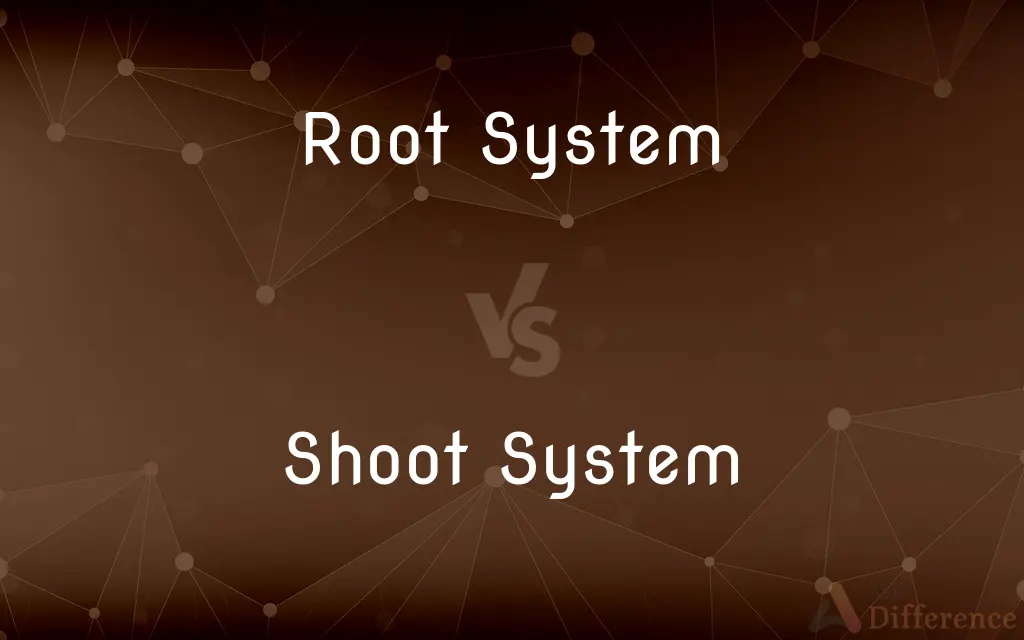Root System vs. Shoot System — What's the Difference?
By Tayyaba Rehman — Published on November 27, 2023
The Root System anchors plants and absorbs nutrients, while the Shoot System includes stems, leaves, and flowers, involved in photosynthesis and reproduction.

Difference Between Root System and Shoot System
Table of Contents
ADVERTISEMENT
Key Differences
The Root System and Shoot System are the two primary divisions of a plant's anatomy, each playing crucial roles in the plant's survival. The Root System, as the name suggests, consists of the plant's roots. These structures delve into the soil, anchoring the plant firmly in place, and absorbing water and essential nutrients.
In contrast, the Shoot System encompasses the parts of the plant that are typically above ground. This system includes stems, leaves, buds, flowers, and fruits. These structures facilitate processes like photosynthesis, where plants convert sunlight into energy. The Shoot System is not only vital for a plant's energy production but also for its reproductive processes.
While the Root System remains hidden beneath the soil, working silently to support the plant's nutritional and support needs, the Shoot System is the visible part of the plant. It grows towards the sun, displaying the plant's leaves, flowers, and sometimes fruits, contributing to the plant's beauty and function.
The Root System and Shoot System are interdependent, working in tandem to ensure the plant's growth, survival, and reproduction. While roots from the Root System draw up water and nutrients to nourish the plant, the Shoot System provides the roots with sugars produced during photosynthesis.
To sum it up, the Root System is the plant's anchor and nutrient provider, and the Shoot System is its food producer and reproductive center. Together, these systems form the complete structure of vascular plants, ensuring their survival and propagation.
ADVERTISEMENT
Comparison Chart
Definition
Part of the plant below ground.
Part of the plant above ground.
Components
Roots.
Stems, leaves, buds, flowers, and fruits.
Function
Anchors plant, absorbs water and nutrients.
Involved in photosynthesis, support, and reproduction.
Visibility
Typically below ground and not visible.
Visible above ground.
Growth Direction
Grows downward.
Grows upward and outward.
Compare with Definitions
Root System
The foundational structure of plants.
The Root System gives stability against strong winds.
Shoot System
A plant's structure responsible for photosynthesis and reproduction.
The Shoot System contains the leaves which capture sunlight.
Root System
The organ system in plants that takes up water and minerals.
The Root System's health determines the overall vitality of the plant.
Shoot System
The external, visible part of plants, often involved in reproduction.
The Shoot System of apple trees produces delicious fruits.
Root System
The underground network of roots in a plant.
The Root System of cacti is adapted to store water.
Shoot System
The organ system in plants that aids in energy production and propagation.
A healthy Shoot System ensures a plant can produce ample food and seeds.
Root System
The part of the plant that grows below the soil.
The Root System of the tree spread out extensively beneath the ground.
Shoot System
The above-ground part of a plant, including stems and leaves.
The Shoot System of the rose plant was full of vibrant flowers.
Root System
A plant's structure responsible for anchorage and nutrient absorption.
A healthy Root System ensures the plant gets enough water and minerals.
Shoot System
The growth system in plants responsible for height and breadth.
The Shoot System determines how tall a tree can grow.
Common Curiosities
Can plants survive without a Root System?
Typically, no, as the Root System provides essential water and nutrients.
What components make up the Shoot System?
The Shoot System consists of stems, leaves, buds, flowers, and fruits.
Where is the Shoot System located in a plant?
The Shoot System is the above-ground part of a plant.
Does the Root System participate in photosynthesis?
No, photosynthesis primarily occurs in the Shoot System, especially in the leaves.
What is the primary function of the Root System?
The Root System primarily anchors the plant and absorbs water and nutrients.
How do plants absorb water?
Through the Root System, especially root hairs.
What role do leaves play in the Shoot System?
Leaves are the primary sites for photosynthesis in the Shoot System.
Can a plant have multiple Shoot Systems?
Yes, a plant can branch out into multiple stems, each acting as a part of the Shoot System.
Is the Root System always underground?
Mostly, but there are exceptions like aerial roots and prop roots.
Why is the Root System crucial for plant health?
A healthy Root System ensures a plant gets adequate water, nutrients, and anchorage.
How do roots in the Root System get oxygen for respiration?
Roots absorb oxygen from air spaces in the soil.
Can the Shoot System store food?
Yes, the Shoot System, especially in stems and fruits, can store food.
What part of the plant aids in reproduction?
The Shoot System, particularly the flowers and fruits, aids in reproduction.
Which system, Root or Shoot, is involved in flowering?
The Shoot System is responsible for flowering in plants.
How does the Shoot System support the plant?
The Shoot System provides structural support through stems and aids in nutrient production through photosynthesis.
Share Your Discovery

Previous Comparison
Axiom vs. Theorem
Next Comparison
Mexicans vs. Puerto RicansAuthor Spotlight
Written by
Tayyaba RehmanTayyaba Rehman is a distinguished writer, currently serving as a primary contributor to askdifference.com. As a researcher in semantics and etymology, Tayyaba's passion for the complexity of languages and their distinctions has found a perfect home on the platform. Tayyaba delves into the intricacies of language, distinguishing between commonly confused words and phrases, thereby providing clarity for readers worldwide.
















































